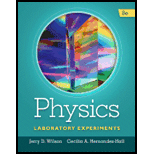
Physics Laboratory Experiments
8th Edition
ISBN: 9781285738567
Author: Jerry D. Wilson, Cecilia A. Hernández-Hall
Publisher: Cengage Learning
expand_more
expand_more
format_list_bulleted
Concept explainers
Question
Chapter 35, Problem 5ASA
To determine
The reason why the second-order spectrum is more spread out than the first order spectrum.
Expert Solution & Answer
Want to see the full answer?
Check out a sample textbook solution
Students have asked these similar questions
Elements in the gaseous state emit line spectra with well- defined wavelengths. But hot solid objects always emit a continuous spectrum—that is, a continuous smear of wavelengths. Can you account for this difference?
Elements in the gaseous state emit line spectra with well- defined
wavelengths. But hot solid objects always emit a continuous spectrum-
that is, a continuous smear of wavelengths. Can you account for this
difference?
If a laser emits light with wavelength lambda
the energy of a single photon in the laser beam?
Use the electron-volt unit of energy, ev.
(in eV)
=
580 nm, then what is
OA: 2.138 OB: 3.100 OC: 4.494 OD: 6.517 OE: 9.450 OF: 13.702 OG: 19.868 OH: 28.808
Chapter 35 Solutions
Physics Laboratory Experiments
Ch. 35 - Prob. 1ASACh. 35 - What is the grating constant? What would be the...Ch. 35 - Explain why there is a spectrum for each...Ch. 35 - Will the red or the violet end of the first-order...Ch. 35 - Prob. 5ASACh. 35 - If a grating with more lines per unit length were...Ch. 35 - Prob. 2QCh. 35 - Prob. 3QCh. 35 - Is there a theoretical limit to the order of the...Ch. 35 - Prob. 5Q
Knowledge Booster
Learn more about
Need a deep-dive on the concept behind this application? Look no further. Learn more about this topic, physics and related others by exploring similar questions and additional content below.Similar questions
- For the wave shown in the figure, the wavelength is yím) I(s) O Cannot be determined from the given information. O 1m. O 2m. O 4 m.arrow_forwardShow that the entire Paschen series is in the infrared part of the spectrum. To do this, you only need to calculate the shortest wavelength in the series.arrow_forwardWhen a hydrogen atom is in its third excided state, what are the shortest and longest wavelengths of the photons it can emit?arrow_forward
- Why are X-rays emitted only for electron transitions to inner shells? What type of photon is emitted for transitions between outer shells?arrow_forwardBriefly explain why the intensities of rotational spectral lines increase with increasing J and pass through a maximum before tailing off as J becomes large.arrow_forwardWhy does the light emitted from excited atoms (like hydrogen or other elements) occur at specific wavelengths as “line spectra” (vs. continuous “white light” like the stuff from the sun)?arrow_forward
- Silver bromide (AgBr) is a light-sensitive substance used in some types of photographic film. To cause exposure of the film, it must be illuminated with light having sufficient energy to break apart the molecules. Why do you suppose this film may be handled without exposure in a darkroom illuminated with red light? How about blue light? How about very bright red light relative to very dim blue light?arrow_forwardThe red lasers used to read the barcodes of products at the grocery stores produce light with a wavelength of 633 nm. The electrical power consumption of a single grocery store laser is 5.00000 × 10-3 J s-1. If the grid is burning CH4 gas (methane) to produce electricity, how many moles of CH4 must be burned to produce enough energy to run the grocery store laser for 365 days? The heat of combustion of methane is -890 kJ/mol. Assume the combustion energy is converted to electricity with 100% efficiency. (Hint, you will need to find the total amount of energy the laser emits as light, assuming the laser works with 100% effeciency i.e. all the electrical energy is converted to 633 nm light) Final answer should be in molarrow_forwardI need the answer as soon as possiblearrow_forward
arrow_back_ios
SEE MORE QUESTIONS
arrow_forward_ios
Recommended textbooks for you
 College PhysicsPhysicsISBN:9781938168000Author:Paul Peter Urone, Roger HinrichsPublisher:OpenStax College
College PhysicsPhysicsISBN:9781938168000Author:Paul Peter Urone, Roger HinrichsPublisher:OpenStax College Foundations of Astronomy (MindTap Course List)PhysicsISBN:9781337399920Author:Michael A. Seeds, Dana BackmanPublisher:Cengage Learning
Foundations of Astronomy (MindTap Course List)PhysicsISBN:9781337399920Author:Michael A. Seeds, Dana BackmanPublisher:Cengage Learning Stars and Galaxies (MindTap Course List)PhysicsISBN:9781337399944Author:Michael A. SeedsPublisher:Cengage Learning
Stars and Galaxies (MindTap Course List)PhysicsISBN:9781337399944Author:Michael A. SeedsPublisher:Cengage Learning
 University Physics Volume 3PhysicsISBN:9781938168185Author:William Moebs, Jeff SannyPublisher:OpenStax
University Physics Volume 3PhysicsISBN:9781938168185Author:William Moebs, Jeff SannyPublisher:OpenStax Modern PhysicsPhysicsISBN:9781111794378Author:Raymond A. Serway, Clement J. Moses, Curt A. MoyerPublisher:Cengage Learning
Modern PhysicsPhysicsISBN:9781111794378Author:Raymond A. Serway, Clement J. Moses, Curt A. MoyerPublisher:Cengage Learning

College Physics
Physics
ISBN:9781938168000
Author:Paul Peter Urone, Roger Hinrichs
Publisher:OpenStax College

Foundations of Astronomy (MindTap Course List)
Physics
ISBN:9781337399920
Author:Michael A. Seeds, Dana Backman
Publisher:Cengage Learning

Stars and Galaxies (MindTap Course List)
Physics
ISBN:9781337399944
Author:Michael A. Seeds
Publisher:Cengage Learning


University Physics Volume 3
Physics
ISBN:9781938168185
Author:William Moebs, Jeff Sanny
Publisher:OpenStax

Modern Physics
Physics
ISBN:9781111794378
Author:Raymond A. Serway, Clement J. Moses, Curt A. Moyer
Publisher:Cengage Learning